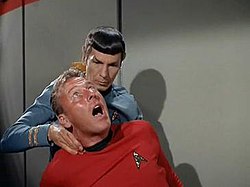
In the fictional Star Trek universe, the Vulcan nerve pinch is a fictional technique used mainly by Vulcans to render unconsciousness by pinching a pressure point at the base of the victim's neck.

In the fictional Star Trek universe, the Vulcan nerve pinch is a fictional technique used mainly by Vulcans to render unconsciousness by pinching a pressure point at the base of the victim's neck.

The script for "The Enemy Within" (1966) stated that Spock "kayoes" (Knocks Out)Captain Kirk (William Shatner)'s duplicate, [1] but Leonard Nimoy, who opposed the Vietnam War and supported Eugene McCarthy, [2] felt that such a brutal action would be unnecessarily violent for a Vulcan. He therefore invented an alternative by suggesting that Vulcans may know enough about human anatomy, or they may have the ability to project telepathic energy from their fingertips, that they could render a human unconscious. [3] The first use of the move would release one week after these events in episode four, "The Naked Time" (1966).
Allegedly, Leo Penn, the director of the episode, did not understand the idea when Nimoy explained it to him, but William Shatner understood immediately and reacted in exactly the way Nimoy had hoped when they executed the move during filming, explaining that it would be similar to "feeling an electrical charge."[ citation needed ] From then on, the pinch was referred to as the "FSNP", for "Famous Spock Nerve Pinch", in Star Trek's scripts.[ citation needed ].
Although entirely fictional, fans and critics of the show have tried to explain how the pinch may work. It has been compared to the "karate chop", which was used implausibly in other 1960s television series to render opponents unconscious. [4]
Nimoy's theory that the pinch may be linked to telepathy is in contrast to when four non-telepathic entities, the android Data,[ citation needed ] Voyager's holographic Doctor,[ citation needed ] Strange New World's La'an Noonien Singh [ citation needed ] and The Next Generation's Captain Jean-Luc Picard [5] use the pinch in later Star Trek television shows.
The book The Making of Star Trek by Stephen E. Whitfield and Gene Roddenberry offers a simple explanation: the pinch blocks blood and nerve responses from reaching the brain, leading to unconsciousness. How this might lead to instantaneous unconsciousness is not explained. In this earliest of Star Trek reference books, the pinch is referred to as the "Spock Pinch." [6]
At least one being, Gary Seven, resists the Vulcan neck pinch during a fight in the episode "Assignment: Earth". Dr. McCoy describes the alien-raised Seven as human, albeit with a perfect body.[ citation needed ]
In the Star Trek: Voyager episode "Cathexis", the Doctor inspects a crewmember who was found unconscious and observes an extreme trauma to the trapezius neck bundle, "as though her nerve fibers have been ruptured"; and it is later revealed that the person was the victim of a nerve pinch.
Along with Spock, various other characters in the Star Trek franchise have used the technique. Notably, the above-mentioned instances with Data and the holographic Doctor, "DS9"'s Changeling, Odo,[ citation needed ] "TNG"'s Jean-Luc Picard,[ citation needed ] "VOY"'s Seven of Nine.[ citation needed ] "ENT"'s T'Pol,[ citation needed ] "Discovery"'s Michael Burnham.[ citation needed ]
However, it is not an easy technique to master. After Spock uses the pinch in the episode "The Omega Glory", Kirk says to Spock, "Pity you can't teach me that", and Spock replies, "I have tried, Captain." In the film Star Trek III: The Search for Spock (1984), Dr. McCoy was unable to use the nerve pinch despite being in possession of Spock's katra (his "spirit" or "soul").
In the film "Star Trek IV: The Voyage Home" (1986), Spock uses the nerve pinch on a disruptive bus passenger. When Kirk and Spock are traveling on a public bus, they encounter a punk rocker blaring his music on a boom box, to the discomfort of everyone around him. Spock takes matters into his own hands and performs a Vulcan nerve pinch. Part of the inspiration for the scene came from Nimoy's personal experiences with a similar character on the streets of New York: "[I was struck] by the arrogance of it, the aggressiveness of it, and I thought if I was Spock I'd pinch his brains out!" [7] On learning about the scene, Kirk Thatcher, an associate producer on the film, convinced Nimoy to let him play the role; Thatcher shaved his hair into a mohawk and bought clothes to complete the part. Credited as "punk on bus", Thatcher (along with sound designer Mark Mangini) also wrote and recorded "I Hate You", the song in the scene, and it was his idea to have the punk—rendered unconscious by the pinch—hit the stereo and turn it off with his face. [7] [8]
The nerve pinch has been shown being used on animals. In the Animated Series episode "Yesteryear", Spock uses the nerve pinch on a Le-matya (a mountain lion-like creature) to save the life of his younger self. In the 1989 film Star Trek V: The Final Frontier , Spock uses the pinch to subdue a horse during a battle.
This article needs additional citations for verification .(February 2020) |
The Vulcan nerve pinch has been referred to, and parodied, in a wide variety of television, film, and other media.